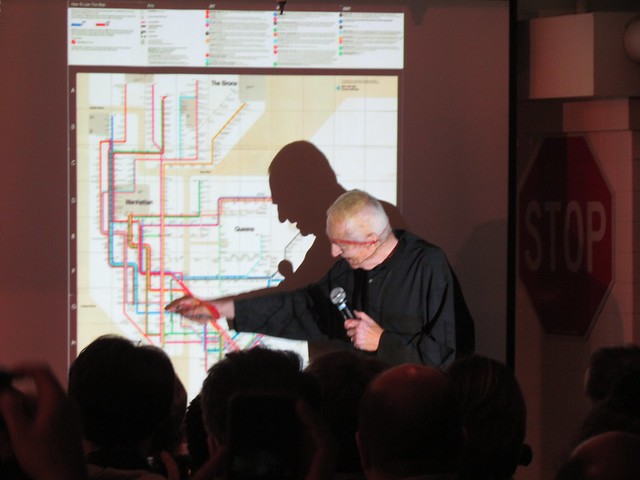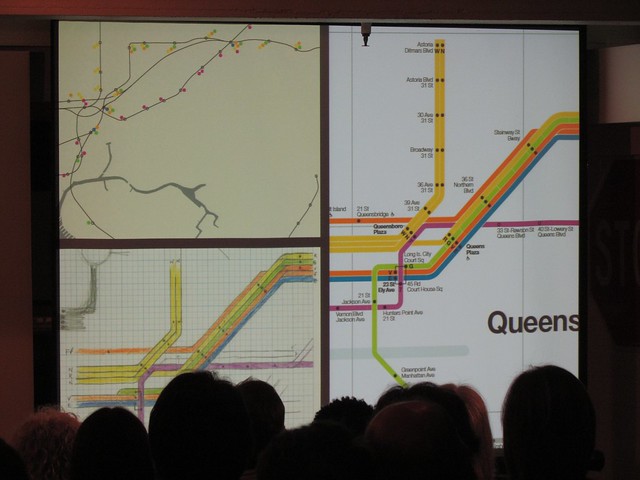 In 1996, at the dawn of New York City’s Metrocard era, the MTA’s average fare tracked closely with the actual fare. A token cost $1.50, and the MTA, thanks to some bulk discounts, saw revenue of $1.38 per fare paid. These days, thanks to unlimited-ride cards and pay-per-ride discounts, the average fare in 1996 dollars is $1.07, far below the rate of inflation. As the MTA looks to keep its books in order, it has tried in recent years to combat this problem.
In 1996, at the dawn of New York City’s Metrocard era, the MTA’s average fare tracked closely with the actual fare. A token cost $1.50, and the MTA, thanks to some bulk discounts, saw revenue of $1.38 per fare paid. These days, thanks to unlimited-ride cards and pay-per-ride discounts, the average fare in 1996 dollars is $1.07, far below the rate of inflation. As the MTA looks to keep its books in order, it has tried in recent years to combat this problem.
Last week at the Crain’s New York breakfast, MTA CEO and Chairman Joe Lhota spoke of this problem. The MTA, he said, quoting information available in the July MTA board materials, sees $1.63 per fare paid in 2012 dollars. With a base fare set at $2.25, it’s clear that New Yorkers are enjoyed some healthy discounts as they ride the subway every day. Now, on the one hand, we should enjoy those discounts. It encourages riders to use the system and promotes better transportation options. On the other hand, the MTA needs more money.
And so, Lhota last week mentioned that the MTA is considering doing away with the pay-per-ride bonus as part of the March 2013 fare hike. After a few years of sticking it to unlimited ride users, certain factions within the MTA believed the authority could better draw in money by dumping what has become a rather meager bonus of 7 percent on all purchases of $10 or more. “Do we really need to go to that level of a discount?” Lhota asked.
Now more details concerning the fare hike proposal are coming into view. Pete Donohue broke the news on Sunday evening concerning the details. Here’s how it looks for Metrocard users:
- l Eliminate the 7% MetroCard bonus. A rider who now puts $10 on a MetroCard gets an additional 70 cents of added value.
- Raise the base bus and subway fare to $2.50, from $2.25.
- Raise the price of an unlimited-ride MetroCard by 5%. A 7-Day MetroCard, now $29, would cost about $30. A monthly MetroCard, now $104, would cost about $109.
The MTA will also, Donohue notes, raise fares for Metro-North, the LIRR and its bridge and tunnel tolls while continuing to fight for the revenue it sorely needs from the payroll mobility tax.
With the discounts completely gone and the base fare going up, that’s a substantial hike for pay-per-ride users. With the current bonus, a swipe costs $2.10, and jacking it up by 40 cents would represent a hike of nearly 20 percent. Unlimited ride users who were shafted a few years ago would see a more modest increase, and the math would clearly favor unlimited riders. The breakeven point on a monthly card would drop from 50 rides to 44 and on a weekly card from 14 to 12. If this hike goes through, I wonder how long it will take riders to realize this shifting math of a subway fare.
Ultimately, this subway fare hike will be shaped by public input. We’ve seen proposals come and go in the face of public pressure, but the truth remains that the hike will happen. The MTA needs to bring in over $360 million next year, and without support from Albany, the only way to do so is through a fare increase. This one seems to make sense right now. Will we be able to say the same in 2015?


















